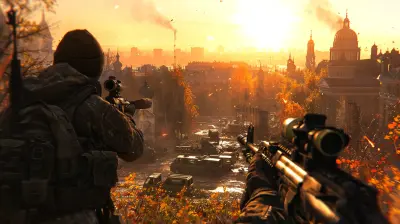Creating Multiplayer Games: Synchronizing Players Over the Network
15 November 2025
Online multiplayer games are everywhere—from battle royales and RPGs to co-op survival games and competitive sports sims. But while the gameplay may seem seamless on the surface, there’s a whole world of complexity behind the scenes, especially when it comes to getting players in sync across the network.
If you’ve ever wondered how developers keep players shooting at the same targets, chasing the same flags, or fighting the same zombies without glitching into chaos, you’re in the right place. Buckle up—we're diving deep into the magic of synchronizing players over a network in multiplayer games.
Understanding the WHY: Multiplayer Games and Network Syncing
Let’s start with the obvious question: why is synchronization so important?Imagine you're playing a first-person shooter. You shoot an enemy, but on their screen, they’re already behind cover. Who gets the kill? Or worse—what if you both think you killed each other at the same time? Without proper synchronization, these moments would break the game.
In multiplayer games, every player's device (or client) has a different view of the game world because of latency (a.k.a. lag), bandwidth limitations, and hardware performance. The goal? Get all players more or less seeing and interacting with the same game reality. That’s where syncing comes in.
Multiplayer Game Architecture: The Backbone of Sync
Before you can sync players, you need to decide how your game's network structure is set up. There are two big dogs in this yard:1. Client-Server Model
This is the popular kid on the block. One machine (often called the server) acts as the game’s brain. All the clients (players) connect to it, send their inputs, and get back game state updates.- Pros: Central authority, easier cheat prevention, consistent game state
- Cons: Requires more server resources, can be a single point of failure
2. Peer-to-Peer Model
Here, each player’s device talks to every other device. No central authority—everyone's equal.- Pros: No server costs, works well for small games
- Cons: Harder to synchronize, more risk of cheating, messy with high player counts
For complex games or competitive environments, the client-server model is the go-to. It just makes life easier when it comes to syncing.
The Challenge of Latency: Why Syncing Is So Tricky
Lag. The mortal enemy of online games.Latency is the delay between when a player does something (like pressing a button to jump) and when the server (and other players) know about it. Even 100 milliseconds can cause things to feel off. And remember, not everyone’s connection is created equal.
So how do developers work around this? Let’s break it down.
Techniques for Synchronizing Players
1. Client-Side Prediction
Client-side prediction is kind of like a “best guess.” When you move your character, your game doesn’t wait for the server to say “OK, you moved.” It just goes ahead and shows the movement, assuming the server will agree.- If the server agrees? Great! Nobody notices.
- If the server disagrees? Your screen may correct itself—this is called a “position correction.”
Ever noticed your character snapping back a step during lag? That’s prediction gone wrong. Still, this method keeps games feeling responsive and snappy.
2. Lag Compensation
Ever shoot an enemy and feel like your bullets went through them? That’s timing desync in action.Lag compensation tries to fix this by letting the server “rewind time.” When your bullets fire, the server checks where the enemy was when you pulled the trigger—not where they are now.
Mind-blowing, right? It’s like the server keeps a little time machine just to make things fair.
3. Interpolation and Extrapolation
When syncing player positions, movement needs to look smooth. Two techniques help with this:- Interpolation: The game blends between two known positions to estimate where a player should be. Think of it as connecting the dots with a smooth line.
- Extrapolation: When data is missing or delayed, the game guesses where a player is going, based on their last known direction and speed.
It’s like playing a racing game and seeing your opponent drive straight for a second before suddenly turning—that turn happened while the packets were on coffee break.
4. State Synchronization vs. Event Synchronization
There are two ways you can approach keeping players in sync:- State Syncing: Continuously send the full state of the game (like positions, health, ammo, etc.) to each client.
- Event Syncing: Only send events (like “Player X just fired a rocket”) and let each client update the state on their end.
State syncing is more accurate but eats up bandwidth. Event syncing is leaner, but you have to trust the clients to do the right thing.
Smart developers often use a mix of both depending on the game mechanics.
Combatting Cheaters: Keeping It Fair
In multiplayer games, cheating isn't just annoying—it breaks the entire experience.One of the biggest dangers of poor synchronization is opening the door to cheats like speed hacks, wall hacks, and packet tampering. That’s why most serious games use server-side authoritative logic.
Here, the server doesn’t just relay messages. It verifies them. If a client says “I hit that guy,” the server checks if that was even possible based on physics, timing, and position.
It’s like that teacher in school who never just accepted your homework without giving it a once-over.
Dealing With Packet Loss
Not all data makes it across the network highway smoothly. Sometimes, packets (the bundles of game data sent online) get dropped. No packet = no update.There are two main networking protocols used:
TCP (Transmission Control Protocol)
- Reliable and ordered. Great for things like chat messages or game menus.- But… it's slow and not ideal for real-time syncing.
UDP (User Datagram Protocol)
- Fast, favors speed over reliability.- Perfect for real-time movement or combat syncing.
- Developers often build reliability layers on top of UDP to cherry-pick what needs to always arrive.
Tick Rate and Update Intervals
Another key term: Tick Rate.The tick rate is how often the server updates the game world per second. A higher tick rate (say 60 ticks per second) means better responsiveness—but also more data and server strain.
You have to find a sweet spot based on your game type. Fast-paced shooters lean toward higher tick rates. Turn-based strategy games? You can get away with lower ones.
Synchronizing Different Types of Games
Not all multiplayer games are cut from the same cloth. Here's how syncing varies:1. First-Person Shooters
These demand lightning-fast syncing. Every bullet, jump, or peek from cover needs to be near-instant. Techniques like lag compensation, interpolation, and prediction are critical.2. Real-Time Strategy (RTS)
RTS games often use deterministic lockstep, where all devices run the same simulation and only sync inputs. It saves bandwidth but demands everyone stays perfectly in sync.3. MMORPGs
Tons of players, less twitch-based combat. MMORPGs often use server authority with smart culling (only syncing what’s near the player).4. Cooperative PvE Games
Syncing is easier when you’re not fighting each other. Even so, accurate AI movement and action synchronization still rely on solid network logic.Tools of the Trade: Frameworks and Engines
You don’t have to build everything from scratch. Here are a few popular networking libraries and engines that handle much of the heavy lifting:- Unity (Mirror, Photon, Netcode for GameObjects)
- Unreal Engine (Built-in replication system)
- Godot (Multiplayer API)
- PlayFab, Nakama, Firebase (Backend services)
These tools give developers access to tested systems for syncing players, handling lobbies, matchmaking, and more.
Tips for Indie Devs Just Starting Out
1. Start Small – Don’t create World of Warcraft on day one. Syncing a simple Pong clone is a great first step.2. Test with Real Lag – Emulate bad connections. There are tools for that. Your game shouldn’t only work on a perfect network.
3. Keep It Authoritative – Let the server rule. Trust no client completely.
4. Visual Feedback Matters – If syncing goes haywire, help the player understand (rubber banding, warning icons, etc.).
5. Watch Your Bandwidth – Optimize what data you send and how often. Compress it. Not everyone has fiber.
Conclusion: Synchronization is an Art (and Science)
Multiplayer game syncing isn't just about sending data—it’s about creating the illusion that players across the world are standing in the same digital room, seeing and reacting to the same things.Between latency, prediction, interpolation, and security—there’s a lot to juggle. But get it right, and you’ll be delivering magical moments for players that feel smooth, fair, and real-time.
Whether you’re building a 2D co-op game or the next big FPS, understanding network synchronization is key to delivering an experience players actually want to stick with.
So, the next time you score a last-second headshot or dodge an attack by a pixel, know there’s a whole system behind the curtain making sure it all just works.
all images in this post were generated using AI tools
Category:
Game DevelopmentAuthor:

Francesca West

